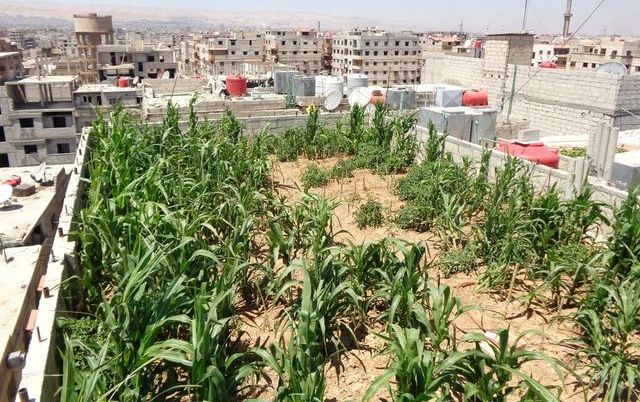D.I.Y. IN DAMASCUS
Rooftop Gardens in Syria's Besieged Neighborhoods

by Youmna al-Dimashqi, Syria Deeply
Rebel-held areas on the outskirts of Damascus have endured more than two years of government blockades aimed at making them surrender or face the prospect of starvation. Disease and malnutrition run rampant and food is scarce.
As in many other such areas across the country, some residents of these besieged areas have mustered the will and energy to adapt and survive, often in ingeniously creative ways.
Notably, rooftop gardens are popping up across the towns that are allowing people to find new ways of feeding themselves and their families. Green patches now dot the rooftops of southern Damascus neighborhoods like Yelda, Babila and Beit Sahem, areas of the capital that have been under government-imposed siege for nearly 24 months.
Hamid Abu Zeid, a 26-year-old law school graduate who lives with his family in the area, said he began sowing seeds on his rooftop when people in his neighborhood started dying of hunger.
"At the beginning, I put 60 bags of dirt in a 15 square meter [160 sq. ft.] area," said Hamid, "but when the blockade tightened even more, I expanded the area to 30 square meters [320 sq. ft.]. I planted things like arugula, radishes, parsley, cilantro and lettuce. That's how I was able to avoid the crazy prices of the market," he said.
Hamid said he was lucky. Seeds, which are hard to find in many of Syria's besieged areas, were available in his neighborhood.
Harvesting his own food, he said, has saved him a great deal of money. Vegetables in blockaded areas are in short supply, and those that are available are sold at exorbitant prices—a bunch of spinach, for example, costs nearly 700 Syrian pounds (about $3.20).
Prices have skyrocketed since Bashar al-Assad's government cut the neighborhoods, and the neighboring area of Yarmouk, off from the rest of the country to starve rebel fighters. But with little no food coming in, it was largely civilians that bore the brunt of the closure. By early 2014, Amnesty International estimated that 200 people in southern Damascus had died of starvation.
According to recent estimates by the U.N., nearly 160,000 people live under government blockade in southern Damascus suburbs.
Unlike the besieged areas in eastern Ghouta, the urban neighborhoods on the southern outskirts of Damascus have little to no agricultural land. And like in almost any other capital city, space is hard to come by. When food began to grow scarce, residents like Hamid had to get creative.
But residents in eastern Ghouta, a well-known rebel held area northeast of Damascus, say they too have had to find other ways to feed themselves.
"The blockade has forced us to find alternatives, especially in towns like al-Buwaidah, hijjera, and al-Sbeneh, where all the surrounding farming lands were destroyed, and many farmers were killed," said Ahmad Abu Farouq, a 19-year-old who lives in Ghouta with his family of nine.
Ahmad said he and his family have turned their 1,600-square-foot (150 sq. meter) rooftop into a year-round farm, planting zucchini and pumpkin in the winter, and lettuce and parsley in the summer. "I throw in a mix of eggplant, peppers and cucumbers when I can," he added.
Eastern Ghouta is frequently and heavily hit by government airstrikes. To protect themselves and their crops, according to Ahmad, most people who have chosen to take up alternative farming find ways to hide their box planters so as not to make them entirely visible from up above.
Abu Ahmad, a 30-year-old pharmacist from eastern Ghouta, said that even though his planter is partly shaded, he's still able to grow eggplants, tomatoes and cucumbers.
"The hardest part was to learn the right time to plant and the right pesticide to use. Some of my plants, for example, died because I did not know which pesticide to use," he said.
Heavy fighting, frequent air strikes and years of government siege has seen the area's pre-war population of five million drop to about 500,000. Many have fled the fighting to other areas in Damascus, or have pushed further on to camps in Lebanon, Jordan or Turkey, while some have made it to Europe.
———
This story first appeared Dec. 10 on Syria Deeply.
Photo: A rooftop garden in southern Damascus in November 2015.
Credit: Ahmad Abu Farooq/Syria Deeply
From our Daily Report:
Syria and Ukraine wars headed for convergence?
World War 4 Report, Dec. 15, 2015
UN rights expert: 'no end in sight' for Syria conflict
World War 4 Report, Sept. 4, 2015
Syria war toll passes quarter million
World War 4 Report, Aug. 11, 2015
See also:
REFUGEES DEFY CRACKDOWN IN TURKEY
by Andrew Connelly, IRIN
World War 4 Report, December 2015
RUSSIA'S SYRIA INTERVENTION... AND THE LEFT
The 'War on Terror' and its New Supporters
by Leila Al Shami
World War 4 Report, November 2015
—————————-
Reprinted by World War 4 Report, Dec. 18, 2015

















Recent Updates
3 hours 49 min ago
3 hours 53 min ago
1 day 4 hours ago
2 days 7 min ago
2 days 21 hours ago
2 days 21 hours ago
3 days 57 min ago
3 days 1 hour ago
3 days 1 hour ago
6 days 4 hours ago